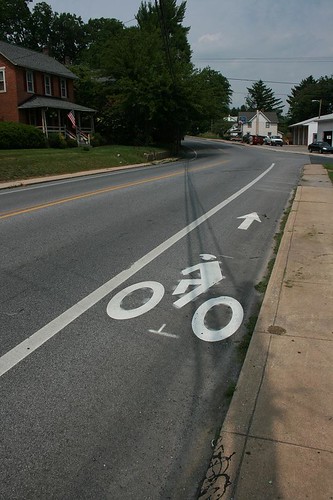Although there are more than 220 miles of bike lanes in the city, there are yawning gaps, but they do bear a semblance to a network. In the PA suburbs, less then 15 miles of bike lanes are laid out over 14703 miles of roadway. This disparity is striking when all bike lanes in Philadelphia and its PA suburbs are mapped.
Density of housing, jobs and destinations are the most important factors that generate bike trips. You can clearly see this in places like the Netherlands where urban cycle-tracks are shoulder to shoulder with bicyclists while the long distance bikeways look and feel like the outer stretches of the Schuylkill River Trail on a nice weekend.
As we know from the low rates of bike commuting in the outer neighborhoods of Philadelphia, bike infrastructure alone won't get everyone in the saddle because standard bike lanes only offer a modest amount of comfort. Yet for thousands of everyday cyclists, bike lanes do offer access, mobility, and a sense of legitimacy to a hostile and sometimes threatening street environment.
The reasons contributing to why bike lanes end at the City line are many. For one, the state considers Philadelphia a "Class 1" city (as well as a Class 1 County) and is therefore accorded a level of control over its road network that suburban municipalities don't have. Compounding that fact are additional obstacles that deter suburban municipalities from installing bike lanes, such as:
- PENNDOT controls most of the arterial roads and therefore has the final say on the roads that make the most critical connections;
- Suburban elected officials, attorneys, engineers and contractors have little or no experience in bikeway development and fear "liability;"
- Before any municipality can allow the installation of a bike lane on a state road, PennDOT requires the municipality to assume the maintenance and liability responsibility for the bike lane portion of a state road by signing onto a Bikeway Occupancy Permit (BOP).
Municipalities -
- Create, implement and adopt a formal bicycle and pedestrian plan.
- Create a bicycle advisory committee to oversee plan implementation
- Use the resurfacing program to implement the bike plan and install bike lanes
- Adopt a Complete Streets Policy
While a bike plan is needed to create a skeleton network of bikeways in the near future, a complete streets policy provides an opportunity to improve all streets for all modes of travel over the long term.
Counties -
- Create County Wide bicycle plans
- Authorize a county bike and pedestrian committee
- Use Open Space grants to help implement the bike plans and install bikeways
PENNDOT
- Commit to abolishing the BOP requirement and implement the necessary legal steps to do so.
- Participate in County Bike Planning efforts and overlay bike plans into the state highway resurfacing program.
- Replace District Bicycle and Pedestrian Coordinators with a statewide Bicycle and Pedestrian office with adequate staff to review projects and policies in all PENNDOT Districts.
- Adopt a bonafide Complete Streets Policy (it currently has "checklist" that serves as a policy).
- Adopt the 2009 Manual on Uniform Traffic Control Devices (it has two years to adopt, so the deadline is approaching).
- Adopt the NACTO Urban Design Guide and the AASHTO Guide for the Development of Bicycle Facilities.
- Host professional development training in bikeway design for county and municipal engineers and planners.
- Set aside a planning fund line item specifically for the development of bicycle and pedestrian plans. Currently the best opportunities municipalities have is to apply for funds under the very competitive Transportation Community and Development Initiative (TCDI) program, which has funded less than a half dozen bicycle and pedestrian plans.
- Offer technical assistance for municipalities and PENNDOT to implement plans, such as evaluating resurfacing programs for bike lane installation.
- Develop a strategy to unclog the $90 Million Dollar Transportation Enhancements project backlog
- Continue and expand the agency's road safety audit program.
- Host professional development training in bikeway design for county and municipal engineers and planners.

The Mileage of bike lanes nearly doubled when PENNDOT and Chester County installed 5 miles of bike lanes on Old Baltimore Pike and PA 41 near Avondale. Photo - Chester County Planning Commission.


3 comments:
Uhmmm.... Errr....
You do realize that "Greater Philadelphia" extends across the Delaware into New Jersey? Why not any analysis on the bike lanes, or lack there of, in New Jersey as well?
We calculated 83 miles of bike Lanes in Mercer, Burlington and Camden Counties. Gloucester has no bike lanes.
In New Jersey the barriers for bike lanes are political. they don't have the extra layer of legal issues that have been build into PennDOT's regulations.
What about the Perkiomen Trail, Cross County Trail, and other multi-use trails out in the suburbs? Suburban counties are attempting to offer biking infrastructure mainly by increasing trails rather than providing bike lanes. Montgomery County's transportation plan shows this quite clearly, with an extensive multi-use trail network rather than a large bike-lane network.
Post a Comment